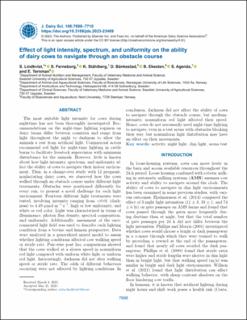Effect of light intensity, spectrum, and uniformity on the ability of dairy cows to navigate through an obstacle course
Peer reviewed, Journal article
Published version
Permanent lenke
https://hdl.handle.net/11250/3124588Utgivelsesdato
2023Metadata
Vis full innførselSamlinger
Originalversjon
Lindkvist, S., Ferneborg, S., Ståhlberg, K., Bånkestad, D., Ekesten, B., Agenäs, S. & Ternman, E. (2023). Effect of light intensity, spectrum, and uniformity on the ability of dairy cows to navigate through an obstacle course. Journal of Dairy Science, 106(11), 7698-7710. doi: 10.3168/jds.2023-23469Sammendrag
The most suitable light intensity for cows during nighttime has not been thoroughly investigated. Recommendations on the night-time lighting regimen on dairy farms differ between countries and range from light throughout the night to darkness to allow the animals a rest from artificial light. Commercial actors recommend red light for night-time lighting in cattle barns to facilitate livestock supervision with minimum disturbance for the animals. However, little is known about how light intensity, spectrum, and uniformity affect the ability of cows to navigate their indoor environment. Thus, in a change-over study with 12 pregnant, nonlactating dairy cows, we observed how the cows walked through an obstacle course under different light treatments. Obstacles were positioned differently for every run, to present a novel challenge for each light environment. Fourteen different light treatments were tested, involving intensity ranging from <0.01 (darkness) to 4.49 µmol m−2 s−1, high or low uniformity, and white or red color. Light was characterized in terms of illuminance, photon flux density, spectral composition, and uniformity. Additionally, assessment of the environmental light field was used to describe each lighting condition from a bovine and human perspective. Data were analyzed in a generalized mixed model to assess whether lighting conditions affected cow walking speed or stride rate. Pair-wise post hoc comparisons showed that the cows walked at a slower speed in nonuniform red light compared with uniform white light or uniform red light. Interestingly, darkness did not alter walking speed or stride rate. The odds of different behaviors occurring were not affected by lighting conditions. In conclusion, darkness did not affect the ability of cows to navigate through the obstacle course, but medium-intensity, nonuniform red light affected their speed. Hence, cows do not necessarily need night-time lighting to navigate, even in a test arena with obstacles blocking their way, but nonuniform light distribution may have an effect on their movements.

